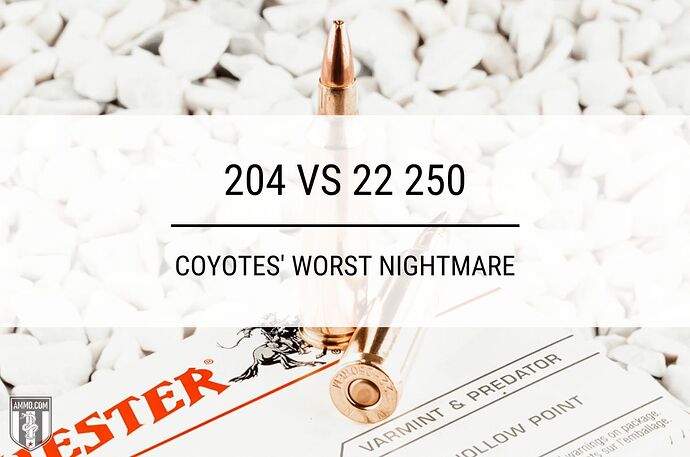Even if you’re new to varmint hunting, you’ve heard of the 204 Ruger and the 22 250 centerfire cartridges. They’re two of the best coyote cartridges on the market.
While we know these calibers are better than many others in specific situations, how do they fair when pitted against each other?
Keep reading to see how the 204 vs 22 250 stacks up compared in ten critical categories.
204 vs 22 250
The 22 250 has had a devoted following for many decades, while the 204 Ruger is only a couple of decades old.
The following categories are what matter most to the average hunter and shooter. We will keep a tally of each section’s winner and declare the winner in the conclusion.
Let’s get started with a cartridge comparison!
Cartridge Specs
The 204 Ruger parent case is the 222 Remington Magnum necked down to 0.204". The shoulders were pushed forward slightly and increased the angle to 30 degrees.
The .250-3000 Savage necked down to accept 22 caliber bullets is the parent case for the 22-250.
The 204 has a base diameter of 0.3764", and the 22 250 has a base diameter of 0.47".
The neck diameter of the 204 Ruger is 0.2311" and 0.254" for the 22-250.
The 204 Ruger shoots a slightly smaller diameter bullet of 0.204", while the bullet diameter of the 22-250 is 0.224".
The case length for the 204 is 1.85", and the 22 250 has a slightly longer case length of 1.912".
The 204 Ruger has an overall length of 2.2598", and the 22-350 comes in at 2.35".
33.2 gr H2O is what to expect for the case capacity of the 204 Ruger, while the 22-250 has a case capacity of 44.6 grains.
Lastly, the maximum pressure (SAAMI) for the 204 is 57,500 psi, and the 22-250’s max pressure is 53,000 psi.
Recoil: 204 Ruger vs 22 250
Recoil is an essential consideration because a round with heavy recoil is more difficult to control and will slow the rate of follow-up shots.
Recoil is primarily affected by muzzle velocity (FPS), powder charge, bullet weight, and rifle weight.
Both calibers have very low recoil, but the 22-250 is almost double that of the 204 Ruger.
This might sound like a lot, but it’s not much of a difference when you look at the numbers.
The 204 Ruger has 3.8 ft-lbs of free recoil when chambered in a typical 7lb rifle.
The 22-250 will have free recoil energy of 6.72 ft-lbs when fired from a 7lb rifle.
The winner is the 204 Ruger. Most shooters will notice a little difference, but neither caliber will leave your shoulder sore from shooting it, so don’t let this be the determining factor.
Trajectory
The trajectory of the bullet is the bullet’s path to the target. It is an arch because gravity pulls the bullet down.
To counteract gravity, a higher velocity is needed. When the bullet’s velocity is increased, it will resist gravity for longer.
The trajectory is important to consider because it’s easier to be more accurate with a flatter trajectory.
The trajectory will change when you use different bullets, so take these numbers lightly. They’re only intended to give you an idea of what to expect from each caliber.
The 32 gr V-MAX load for the 204 has the flattest trajectory with only -31.8" of bullet drop at 500 yards.
At 500 yards, the 22-250 Rem 40 gr Nosler Ballistic Tip has a bullet drop of -36.2".
While both rounds have a relatively flat trajectory out to 500 yards, the 204 is capable of a flatter trajectory and wins this section.
Continue reading 204 vs 22-250: Coyotes’ Worst Nightmare on Ammo.com


